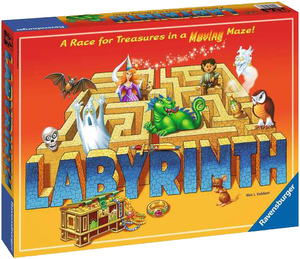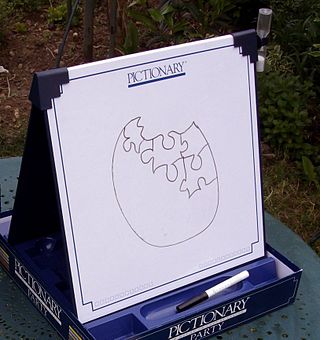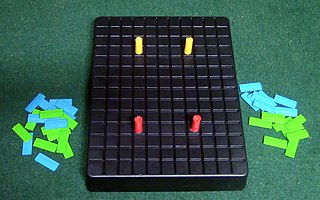 | |
| Manufacturers | Ravensburger |
|---|---|
| Designers | Max Kobbert |
| Publication | 1986 |
| Players | 2-4 |
| Age range | 7 and up |
| Website | Official website |
Labyrinth is a board game for two to four players, published by Ravensburger in 1986.
 | |
| Manufacturers | Ravensburger |
|---|---|
| Designers | Max Kobbert |
| Publication | 1986 |
| Players | 2-4 |
| Age range | 7 and up |
| Website | Official website |
Labyrinth is a board game for two to four players, published by Ravensburger in 1986.
The game board forms a maze built of both fixed and moving pieces. The players rearrange the maze to their advantage by moving a row of pieces in turn. Each player has one token, which they move in the maze. The player's goal is to collect treasures in the labyrinth and then return to their own starting position. The treasures appear in the cards that are dealt to the players in the beginning of the game. [1]
The player is allowed to see only the card that shows their current destination. The player has to reveal the card when they reach the destination, and take a new card from their pile. The other players notice when the pile is empty, and then usually try to prevent the leading player from returning to the starting position. Advanced players also try to guess other players' destinations in order to make their proceeding more difficult or try to trap them in dead ends. [1]
The game was designed by the German psychologist Max Kobbert and published by Ravensburger under the name "Das verrückte Labyrinth", which is a pun on the German words "verrücken" (displace) and "verrückt" (crazy), roughly translatable in English as "labyrinthal disorder". In English-speaking countries, the name was initially translated as "THE aMAZEing LABYRINTH", but the pun was dropped in subsequent versions.
Ravensburger has published a number of follow-on labyrinth games, starting with an advanced version of the game, Master Labyrinth, created by Kobbert in 1991. This version of the game won the 1991 Mensa Select award, the 1991 Deutscher Spiele Preis, and the Spiel des Jahres special award for "most beautiful game". It was followed by Junior Labyrinth (1995), a simplified version on a smaller board with fewer items to find; Secret Labyrinth (1998), a version on a circular board with simplified combat; the Labyrinth Card Game (2000); 3-D Labyrinth (2002), a version with a plastic 3D board; Lord of the Rings Labyrinth, a book/movie themed version; Labyrinth Treasure Hunt (2005), a version which features simultaneous play; and a dragon-themed version again called Master Labyrinth (2007).
In February 2008, videogame website DS-x2.com reported that dtp entertainment was planning a Nintendo DS version of the board game. [2] Three months later, they included screen shots of the game, [3] but ultimately it was never released.
In 2009-2010, the RIT CS department adopted the game for a freshman-level CS project in the Python programming language. [4]
In July 2010, LEGO game Harry Potter Hogwarts (number 3862) was released that follows a similar game mechanic. Each player must collect one copy of each of four items and return to their start position. At the start of each player's turn the player rolls the dice to determine in what way they can change the layout of the board. [5]

Scotland Yard is a board game in which a team of players controlling different detectives cooperate to track down a player controlling a criminal as they move around a board representing the streets of London. It was first published in 1983. It is named after Scotland Yard which is the headquarters of London's Metropolitan Police Service in real-life. Scotland Yard is an asymmetric board game, during which the detective players cooperatively solve a variant of the pursuit–evasion problem. The game is published by Ravensburger in most of Europe and Canada and by Milton Bradley in the United States. It received the Spiel des Jahres award in 1983-the same year that it was published.

Pictionary is a charades-inspired word-guessing game invented by Robert Angel with graphic design by Gary Everson and first published in 1985 by Angel Games Inc. Angel Games licensed Pictionary to Western Publishing. Hasbro purchased the rights in 1994 after acquiring the games business of Western Publishing. Mattel acquired ownership of Pictionary in 2001. The game is played in teams with players trying to identify specific words from their teammates.

Reiner Knizia is a prolific German-style board game designer.

Family Business is a card game of "mob vengeance" for 2 to 6 players, published by Mayfair Games in 1982, and then again in 1989.
Skip-Bo is a commercial version of the card game Spite and Malice, a derivative of Russian Bank, which in turn originates from Double Klondike. In 1967, Minnie Hazel "Skip" Bowman (1915–2001) of Brownfield, Texas, began producing a boxed edition of the game under the name SKIP-BO. In 1980 the game was purchased by International Games, which was subsequently bought by Mattel in 1992. A mobile version of the game for iOS was released by Magmic in September, 2013. There is a new version called "SKIP-BO Mod" that comes in a white and blue case.

Hare and Tortoise is a Eurogame designed by David Parlett in 1974 and first published by Intellect Games. In 1978 it was released by Ravensburger in Germany, and received generally positive reviews critically and won the 1979 Spiel des Jahres. It has since sold some 2 million units in at least ten languages. The current editions are published by Gibsons Games in the UK, Ravensburger in Germany and Rio Grande Games in the United States.
The Warlock of Firetop Mountain is a Games Workshop adventure board game published in 1986, based on the Fighting Fantasy gamebook The Warlock of Firetop Mountain. The game can be played by 2-6 players. A typical game has a length of two hours.

Lego Harry Potter is a Lego theme based on the film series of the same name and the eponymous novels by British author J. K. Rowling. It is licensed from Warner Bros. Lego models of important scenes, vehicles and characters were made for the first six films and all of the published books. The first sets appeared in 2001, to coincide with the release of the first film, Harry Potter and the Philosopher's Stone. Subsequent sets were released alongside the new films, until Harry Potter and the Order of the Phoenix. The line then went dormant for three years, with sets being released in 2010 and 2011. In 2018, it was announced that more sets based on the Harry Potter franchise would be released, including new sets based on Fantastic Beasts and Where to Find Them and its sequel, Fantastic Beasts: The Crimes of Grindelwald.

Isolation is an abstract board game published by Ravensburger in 1972 in Germany as Isola, and then published internationally by licensed game companies under the titles Stranded and Isolation.
Orient Express is a crime fiction board game published by Jumbo and Just Games. The game is based on the 1934 novel Murder on the Orient Express by Agatha Christie. The game was designed by Jeff Smets and released in 1985. The game contains 10 different murder cases, each of which can be played only once. Five new plots were released in 1987.

Blockade is a strategy board game for two players with the motto "beat the barrier". It is played with barriers and 2 mobile playing pieces per player on a grid of 11x14 spaces. The object of the game is to maneuver one's pieces around barriers and into the opponent's starting spaces. The game is long out of production.
Lego Games was a product range of the construction toy Lego. The theme was first introduced in 2009.

Lego Harry Potter: Years 1–4 is a Lego-themed action-adventure video game developed by Traveller's Tales and published by Warner Bros. The game is based on the Lego Harry Potter toy line, and its storyline covers the first four books by J.K. Rowling and its film adaptations in the Harry Potter film series: Harry Potter and the Philosopher's Stone (2001), Harry Potter and the Chamber of Secrets (2002), Harry Potter and the Prisoner of Azkaban (2004), and Harry Potter and the Goblet of Fire (2005).

Dungeons & Dragons Computer Fantasy Game is a handheld electronic game released by Mattel in 1981. Designer Peter Oliphant claims that it was one of the more basic projects he worked on during his career.

The Dungeons & Dragons Computer Labyrinth Game is an electronic board game released by Mattel in 1980.
A deck-building game is a card game or board game where construction of a deck of cards is a main element of gameplay. Deck-building games are similar to collectible card games (CCGs) in that each player has their own deck. However, unlike CCGs, the cards are not sold in randomized packs, and the majority of the deck is built during the game, instead of before the game.

4000 A.D. is a science fiction conquest board game published by Waddingtons in 1972.

The Harry Potter video games are a series of video games based on the Harry Potter franchise originally created by J. K. Rowling. Many of the Harry Potter-inspired video games are tie-ins to the novels and films of the same name. The main series features a video game for every novel, as well as two for the finale. There are multiple distinct versions for individual games.

Armada is a board game published by Jeux Descartes in 1986. After Jeux Descartes published a second edition, Eurogames published a third edition in 2001 that changed the theme of the game from colonisation to treasure-seeking pirates.
Maloney's Inheritance is a board game published in 1988 by Ravensburger.